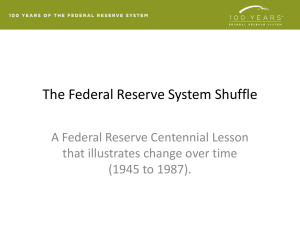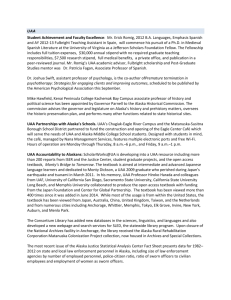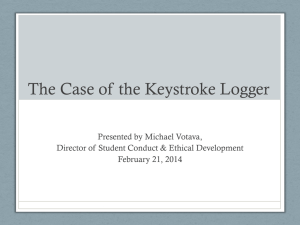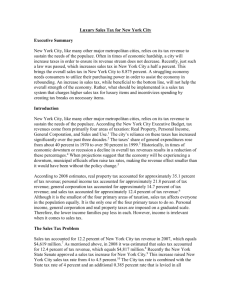Kachemak Bay Research Reserve Community Council Minutes
advertisement
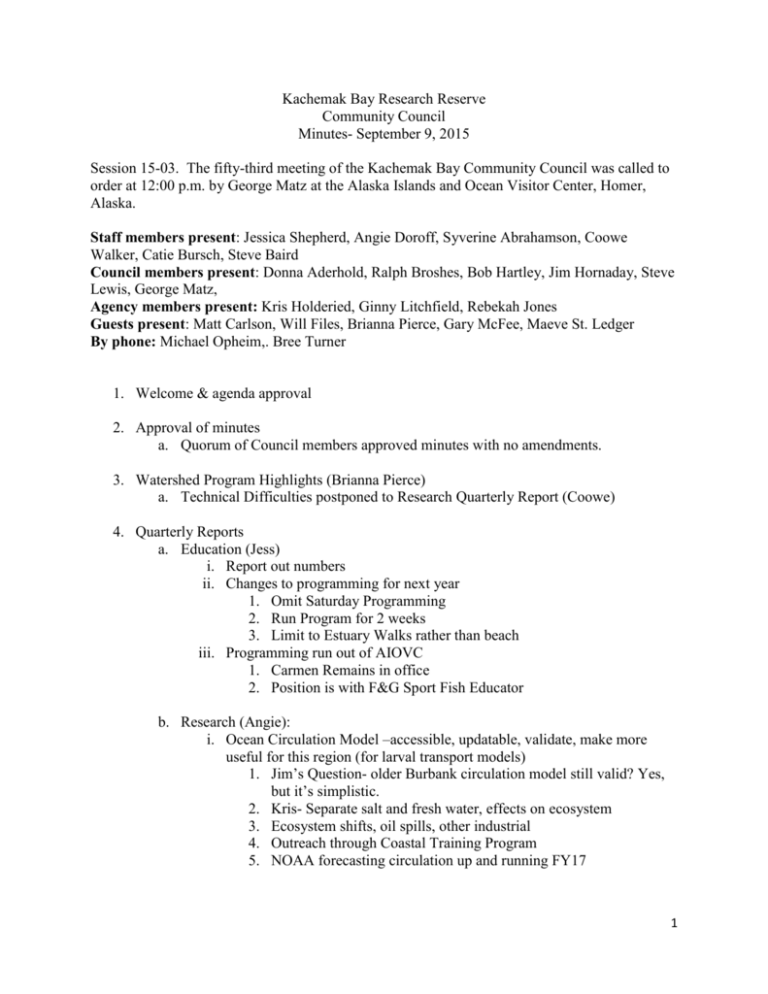
Kachemak Bay Research Reserve Community Council Minutes- September 9, 2015 Session 15-03. The fifty-third meeting of the Kachemak Bay Community Council was called to order at 12:00 p.m. by George Matz at the Alaska Islands and Ocean Visitor Center, Homer, Alaska. Staff members present: Jessica Shepherd, Angie Doroff, Syverine Abrahamson, Coowe Walker, Catie Bursch, Steve Baird Council members present: Donna Aderhold, Ralph Broshes, Bob Hartley, Jim Hornaday, Steve Lewis, George Matz, Agency members present: Kris Holderied, Ginny Litchfield, Rebekah Jones Guests present: Matt Carlson, Will Files, Brianna Pierce, Gary McFee, Maeve St. Ledger By phone: Michael Opheim,. Bree Turner 1. Welcome & agenda approval 2. Approval of minutes a. Quorum of Council members approved minutes with no amendments. 3. Watershed Program Highlights (Brianna Pierce) a. Technical Difficulties postponed to Research Quarterly Report (Coowe) 4. Quarterly Reports a. Education (Jess) i. Report out numbers ii. Changes to programming for next year 1. Omit Saturday Programming 2. Run Program for 2 weeks 3. Limit to Estuary Walks rather than beach iii. Programming run out of AIOVC 1. Carmen Remains in office 2. Position is with F&G Sport Fish Educator b. Research (Angie): i. Ocean Circulation Model –accessible, updatable, validate, make more useful for this region (for larval transport models) 1. Jim’s Question- older Burbank circulation model still valid? Yes, but it’s simplistic. 2. Kris- Separate salt and fresh water, effects on ecosystem 3. Ecosystem shifts, oil spills, other industrial 4. Outreach through Coastal Training Program 5. NOAA forecasting circulation up and running FY17 1 ii. Gulf watch- Coffee table and Discovery Lab outreach of long term monitoring project iii. Habitat Focus Area- collaboration w/UAA, clam species data models iv. SWG-HAB and Marine invasives c. Community Monitoring/Harmful Species (Catie) i. Green Crab: None present. Will be interesting to see what happens in this warm year with northward movement ii. Tunicates: new species, waiting for ID of new species iii. HAB: Pacific coast-wide bloom of potentially harmful species, tested nontoxic here. 1. Mechanism for Domoic Acid production unknown 2. George Question: Whale deaths? Inconclusive iv. Unusual year, no bioluminescence, herring presence, black cod v. Broadening our partner base for Alaska-wide sampling d. Research (Coowe): i. Watershed Program Highlights (Brianna Pierce): Anchor River Estuary, Bio-productivity, Unite landscape, Rearing habitat 1. Project helps identify critical habitat, make the biggest impact. 2. Sampling, tagging and recapture: 95% of catch Coho, Staghorn Sculpin, Starry Flounder, Stickleback. Also see dolly, rainbow, chinook, sockeye, chum, and lamprey. 3. Trends: High site fidelity, do move considerable distances 4. Next year plan longer sampling season, antennas will stay in over winter. Will be interesting to check winter movement and residence patterns. Develop a mechanistic model of habitat drivers. 5. Questions: a. More antennas upstream? Not capable to span channels. Fix one to weir to track returning adults. b. PIT tags affect fish? Heal quickly, pass along. c. Temp/fish productivity? Metabolism high with higher temps, but cannot exceed threshold. Our work can help with Arctic regions as salmon habitat changes and expands. d. Diet Analysis Expectations? Prey availability, preference, type, for each age class of fish. Bait salmon eggs in stomachs- kill juveniles. e. Communities: Sculpin function as predators, interesting to track their movements. 5. Transition Update (Jess and Matt): a. Jess: Packing up to move to Kachemak Drive i. Move Days are Friday September 18th, Friday the 25th ii. Estuary CoastWalk with community for National Estuaries Day b. Facilities: Transfer K Drive property, could take a little longer 2 c. Upcoming meetings: West Coast Managers Meeting, AAAS Healthy Estuaries Meeting, National NERR Meeting, AFS here in Homer, CACC workshop, Scenario Planning Workshops in 2016 and 2017. d. Budget: 2016 $2.2 million, University overhead is about 10%, of that about 75% comes back to support Reserve. Staff has decided to fly CTP position by January. e. Matt: UAA strongly supportive, close mission alignment, really glad to see all the support at the commemoration event. i. Background of AKNHP- conservation data to help inform management decisions regarding habitats of concern. Many partners contribute data to serve purpose. ii. Matt will be confirmed director at the end of September f. Reserve leadership: Continue to have Jess in the dual role for the foreseeable future BREAK 6. Community Council Review (George): a. Matt: Council has been playing a pivotal role recently for Reserve; we need to keep it functional. UAA doesn’t have huge precedent for these organizations, but it doesn’t look like we need to make huge changes to Charter. b. Steve: Council is critical in creation and has sustained Reserve i. Through transitions from Habitat to Sport Fish and to UAA. ii. Council is a great model for community involvement iii. Need to do some wordsmithing and review charter (has been done twice previously) c. Council Function: i. Great capacity for bringing in agencies and collaborations (Angie and Ginny) ii. Voting members put the stamp on things, but consensus involves all agency members (Steve) iii. Council outreaches Reserve communications (Jim) iv. Council is a touchstone for driving Reserve research and education, enhance reserve work (Catie) v. Provides the local input in the Fed-State-Local partnership (Will) vi. Charter adjustment to be more proactive? Supporting legislation, talking to city council/borough assembly…(Will) vii. Council membership should expand with a wider representation 1. Marine Working Group 2. Watershed Working group Reserve Responsibility: 3. Local research- Export knowledge to applications statewide 4. Bree: reserve can have a broad reach especially through CTP 5. Jess: Education has seen interchange from adjacent areas d. New Council Members (George) i. How to appoint? UAA confirm appointments (Matt) ii. Recruitment by manager and council 3 iii. Take it slow this year on appointments iv. Council seats represent entire community e. Next Steps (George and Jess meet on forming committees) i. Recruitment: Agency members, UAA should invite, outreach after transition 1. Update prospectus under UAA for agency ii. Charter Development iii. Council Packet 7. Council and Public Comments: a. Kris: Pre-spawn salmon stranding due to low water i. Michael: natural run coho and sockeye, dead herring, clams, birds ii. Angie: Sea otter mortality up Meeting adjourned 2:55 pm 4



